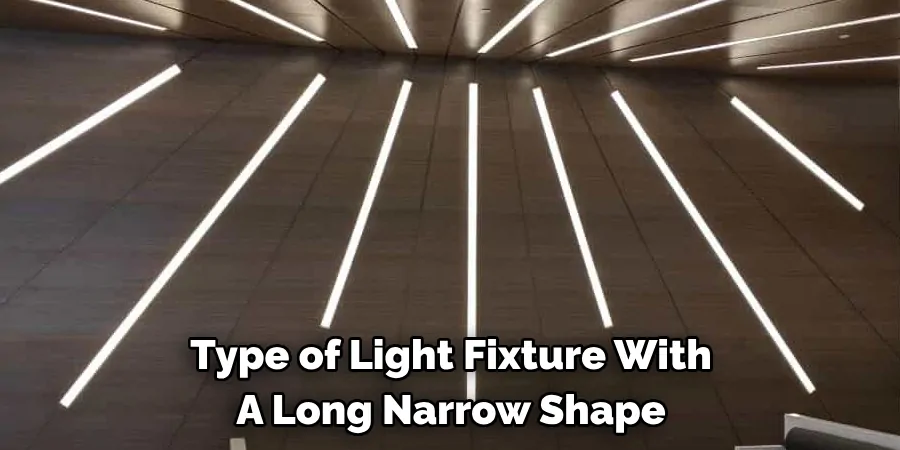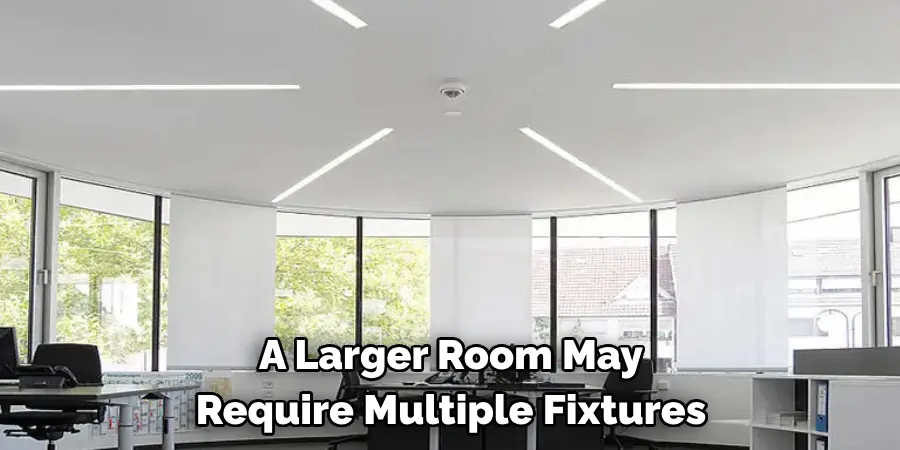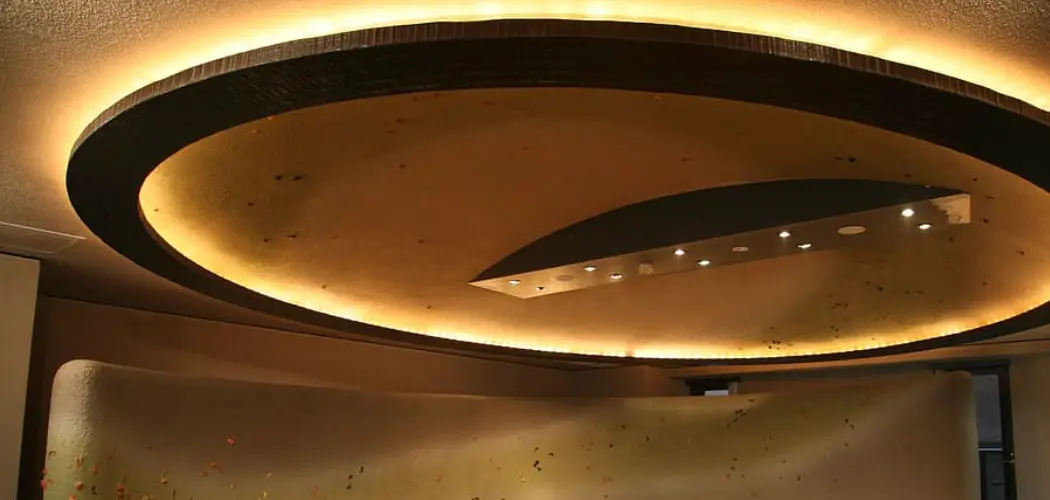Linear lighting fixtures are sleek, modern, and versatile. They can be used for both functional and decorative purposes in a home. Linear lighting refers to any type of lighting that is long and narrow in shape, such as strip lights or linear pendant lights. Lighting is an important element in design. It can completely transform the look and feel of a space, creating atmosphere and setting the mood.

Linear lighting, in particular, is a popular choice for both residential and commercial spaces due to its sleek and modern aesthetic. These fixtures can be placed in various areas of your home to add both style and function. In this guide, we’ll discuss how to place linear lighting in your home properly.
Necessary Items
Before getting started, it’s important to have all the necessary items for properly placing linear lighting in your home. These include:
- Linear Lighting Fixtures: As mentioned earlier, there are various types of linear lighting fixtures, such as strip lights or linear pendant lights. Choose the one that best fits your aesthetic and functional needs.
- Appropriate Light Bulbs: Depending on the type of linear lighting fixture you choose, you’ll need to select the appropriate light bulbs. Consider factors such as brightness, color temperature, and energy efficiency when making your selection.
- Mounting Hardware: This is required to install the linear lighting fixtures in your home. Make sure to check the weight limit of your mounting hardware to ensure it can support the weight of your chosen fixture.
- Power Source: Linear lighting fixtures require a power source, so make sure there is an outlet or access to wiring in the area where you plan to place your fixture.
What is Linear Lighting?
Linear lighting refers to any type of light fixture with a long, narrow shape. It can come in various forms, such as strip lights, linear pendant lights, linear chandeliers, and more. These fixtures are ideal for creating a sleek and modern look in a home. They can also be used for task lighting, highlighting specific areas or objects in a room.

8 Things to Know Before You Start
1) Plan Your Placement
Before purchasing your linear lighting fixtures, it’s important to plan where you want to place them in your home. Consider the function of each space and how the lighting will enhance it. For example, linear pendant lights work well over kitchen islands or dining tables, while strip lights can be used under cabinets or along staircases.
2) Consider Height and Scale
When placing linear lighting fixtures, it’s important to consider the height and scale of the space. For example, if you have high ceilings, a large linear chandelier would be more suitable than smaller pendant lights.
3) Determine the Number of Fixtures Needed
The number of linear lighting fixtures needed will depend on the size and function of the space. A larger room may require multiple fixtures for adequate lighting, while a smaller space may only need one.
4) Use Dimmers
Dimmers are a great way to control the intensity of your linear lighting. They also allow you to create different moods and ambiance in a room. Make sure to choose dimmable light bulbs for your fixtures.
5) Consider Color Temperature
The color temperature of a light bulb can greatly impact the overall feel of a room. For example, warm white bulbs (2700K-3000K) create a cozy and intimate atmosphere, while cool white bulbs (4000K-5000K) are more suitable for task lighting in areas such as kitchens and bathrooms.

6) Think About Energy Efficiency
LED linear lighting fixtures are the most energy-efficient option, using less energy and lasting longer than traditional incandescent bulbs. They also come in various color temperatures and can be dimmable.
7) Don’t Overlook Installation
Proper installation of your linear lighting fixtures is crucial for both safety and functionality. If you’re not comfortable with electrical work, it’s best to hire a professional for installation.
8) Experiment with Different Placements
Don’t be afraid to try out different placements of your linear lighting fixtures before settling on a final position. You may find that moving the fixture slightly can make a big difference in terms of light distribution and overall aesthetic.
Linear lighting can add both style and function to any space in your home. By considering factors such as placement, height and scale, number of fixtures, and color temperature, you can create the perfect lighting layout for your home. Remember to also use dimmers, consider energy efficiency, and properly install your fixtures for optimal results.

10 Steps on How to Place Linear Lighting
Step 1: Gather Necessary Items
Collect all the necessary items listed above before starting the placement process. This will ensure a smooth and efficient installation. And don’t forget to turn off the power source before handling any electrical work.
Step 2: Measure and Mark
Measure the area where you plan to install your linear lighting fixtures. Use a pencil or painter’s tape to mark the desired placement on the ceiling or wall. So you have a visual reference to work with.
Step 3: Determine the Distance between Fixtures
The distance between linear lighting fixtures will depend on their size and purpose. For general ambient lighting, fixtures should be spaced evenly at about 4-5 feet apart. If used for task lighting, such as over a kitchen island or dining table, they should be placed closer together.
Step 4: Prepare Mounting Hardware
Assemble and prepare the mounting hardware according to the manufacturer’s instructions. Make sure it can support the weight of your chosen fixture. While most fixtures come with mounting hardware, you may need to purchase it separately for others.
Step 5: Install Mounting Hardware
Using the appropriate tools, install the mounting hardware onto your marked spots on the ceiling or wall. Make sure they are securely attached and level. But don’t tighten the screws all the way just yet.
Step 6: Install Power Source
If your linear lighting fixtures require a power source, now is the time to install it. This can be an outlet or wiring that connects to your home’s electrical system. Make sure to follow all safety precautions and consult a professional if needed.
Step 7: Connect Wires
If your fixtures require wiring, carefully connect them to the power source. This step may require the assistance of an electrician.

Step 8: Attach Fixture to Mounting Hardware
Gently lift your chosen fixture and attach it to the mounting hardware using screws or other attachment methods specified by the manufacturer. Make any necessary adjustments for a level and secure fit.
Step 9: Test Light and Adjust Placement
Turn on the power source and test the light. Make any adjustments to the placement if needed, such as moving fixtures closer or further apart. Another option is to add diffusers or lens covers for different lighting effects.
Step 10: Secure Fixtures and Enjoy
Once you are satisfied with the placement, tighten all screws and secure your linear lighting fixtures in place. Now, you can sit back, relax, and enjoy the new ambiance created by your beautifully placed linear lighting. Remember to clean and maintain your fixtures regularly for optimal performance and longevity. Keep these steps on how to place linear lighting in mind when installing linear lighting to achieve the perfect layout for your space. With proper placement and consideration of various factors, you can create a well-lit and visually appealing environment in any room of your home.
8 Things to Avoid When Placing Linear Lighting
1) Avoid Uneven Spacing
Make sure to space out your linear lighting fixtures evenly for a balanced and aesthetically pleasing look. Uneven spacing can create an unbalanced and cluttered appearance. But also consider the purpose of the lighting and adjust spacing accordingly.
2) Don’t Place Fixtures Too Close to Walls
To avoid creating harsh shadows on walls, make sure to keep linear lighting fixtures at least 6 inches away from walls. This will help evenly distribute light and create a softer look. Then, adjust the height of the fixtures for maximum impact.
3) Don’t Ignore Other Light Sources
Linear lighting should be used in conjunction with other light sources to create an overall well-lit space. Avoid relying solely on linear lighting, as it may not provide enough illumination for certain tasks or activities.
4) Don’t Overlook Scale and Proportion
When choosing linear lighting fixtures, consider the scale and proportion of your space. A small fixture may get lost in a large room, while an oversized fixture can overwhelm a smaller room. Choose fixtures that fit the size and style of your space.
5) Avoid Cluttered Placement
Avoid placing too many linear lighting fixtures in one area, as it can create a cluttered look. Instead, space them out evenly and consider using different types of fixtures for a more dynamic look.
6) Don’t Forget to Use Dimmers
Dimmers are an essential tool for controlling the intensity of your lighting. They allow you to adjust the brightness according to your needs or mood, making linear lighting even more versatile and functional.
7) Avoid Disregarding Energy Efficiency
Choose energy-efficient LED bulbs for your linear lighting fixtures to save on electricity costs and reduce your carbon footprint. LED bulbs also last longer, making them a more sustainable choice. So, don’t overlook the importance of energy efficiency when placing linear lighting.
8) Don’t Install Improperly
Improper installation can not only be dangerous but also affect the performance and longevity of your linear lighting fixtures. Make sure to follow all manufacturer instructions and consult a professional if needed for a safe and proper installation.

In summary, with these tips on how to install and avoid common mistakes when placing linear lighting, you can create a beautifully lit space that suits your needs and aesthetic preferences. Careful consideration of spacing, placement, and other factors will help you achieve the perfect layout for your linear lighting. So get creative and have fun designing the perfect lighting plan for your home!
8 Additional Tips for Placing Linear Lighting
1) Consider the Color Temperature
The color temperature of your lighting can greatly impact the mood and atmosphere of a space. For a warm and inviting feel, choose bulbs with a lower color temperature (2700-3000K). For a more energizing and modern vibe, opt for bulbs with a higher color temperature (4000-5000K).
2) Use Linear Lighting as Accent or Task Lighting
In addition to providing ambient lighting, linear lighting can also be used for accent or task lighting. Place fixtures above artwork or in areas where focused light is needed, such as above a kitchen island.
3) Take Ceiling Height into Consideration
The height of your ceiling will play a role in the placement of your linear lighting fixtures. For higher ceilings, consider using longer fixtures or hanging them at a lower height for better visibility. If your ceiling is lower, choose smaller fixtures or mount them closer to the ceiling.
4) Mix and Match Fixtures
Don’t be afraid to mix and match different types of linear lighting fixtures for a more dynamic look. Pairing long and short fixtures or using different designs can add visual interest to your space. While doing so, make sure to consider the spacing and proportions as well.
5) Utilize Corners
Corners are often overlooked when it comes to lighting placement, but they can be a great spot for linear lighting. Use suspended fixtures in corners to create a unique and eye-catching display.
6) Consider the Function of the Space
The function of a space should also be considered when placing linear lighting. For example, a brighter and more evenly lit space may be needed for a kitchen or workspace, while a softer and warmer light may be preferred in a bedroom or living room.
7) Use Linear Lighting to Define Spaces
Linear lighting can also be used to define different areas within an open floor plan. Place fixtures above a dining area or seating area to create separation and add dimension to the space.
8) Don’t Limit Linear Lighting to Just Ceilings
Linear lighting doesn’t have to be limited to just ceilings. Consider using wall-mounted fixtures for a unique and modern look, or use under-cabinet linear lighting for functional and stylish task lighting in your kitchen or workspace. The possibilities are endless! Overall, by keeping these additional tips on how to place linear lighting in mind, you can elevate your linear lighting design and create a well-lit and visually appealing space. So get creative and have fun experimenting with different placements and styles of linear lighting.

Frequently Asked Questions
Can Linear Lighting Be Used Outdoors?
Yes, there are many outdoor linear lighting options available that can add both functionality and style to your outdoor space. These fixtures are designed to withstand outdoor elements and provide ample lighting for patios, decks, or gardens.
How Do I Choose the Right Size Linear Lighting Fixture?
As a general rule of thumb, linear lighting fixtures should be about one-third to half the length of the surface they are illuminating. For example, if you have a 6-foot-long kitchen island, a 2-3-foot linear fixture would be suitable.
Can I Mix Different Types of Linear Lighting?
Yes, you can mix and match different types of linear lighting fixtures for a more unique and customized design. Just make sure to consider the spacing, proportions, and overall aesthetic when doing so.
What Type of Bulbs Should I Use for Linear Lighting?
LED bulbs are the most energy-efficient and long-lasting option for linear lighting fixtures. However, make sure to check the manufacturer’s recommendations for bulb compatibility before making a purchase. Overall, choosing the right bulbs will depend on your personal preferences and lighting needs.
How Can I Dim Linear Lighting?
Dimming linear lighting can be easily achieved with dimmer switches specifically designed for LED lighting. These switches allow you to adjust the brightness of your fixtures according to your preference. Just make sure to choose compatible bulbs and switches for optimal compatibility and performance.
Can Linear Lighting Be Used in Every Room of the House?
Yes, linear lighting can be used in any room of the house. However, consider the function and style of each space when choosing the placement and type of fixtures to ensure they suit your specific needs. So go ahead and get creative with your linear lighting design! Just remember to keep these helpful tips and FAQs in mind for a successful installation.
How Many Linear Lighting Fixtures Should I Use in One Area?
The number of fixtures will vary depending on the size and function of the space, as well as personal preference. As a general guideline, aim for even spacing and avoid overcrowding the area with too many fixtures. So, consider these FAQs when planning your linear lighting layout to ensure you get the best results for your space!

Conclusion
Linear lighting is a versatile and stylish option for illuminating your home. By carefully considering factors like spacing, placement, and other tips mentioned above, you can create a well-lit and visually appealing space that suits your needs and preferences.
Don’t be afraid to get creative with different placements and styles of linear lighting to elevate the overall design of your home. With the proper techniques and planning on how to place linear lighting, you can achieve the perfect lighting plan for your space. So, go ahead and start designing your linear lighting layout today!

